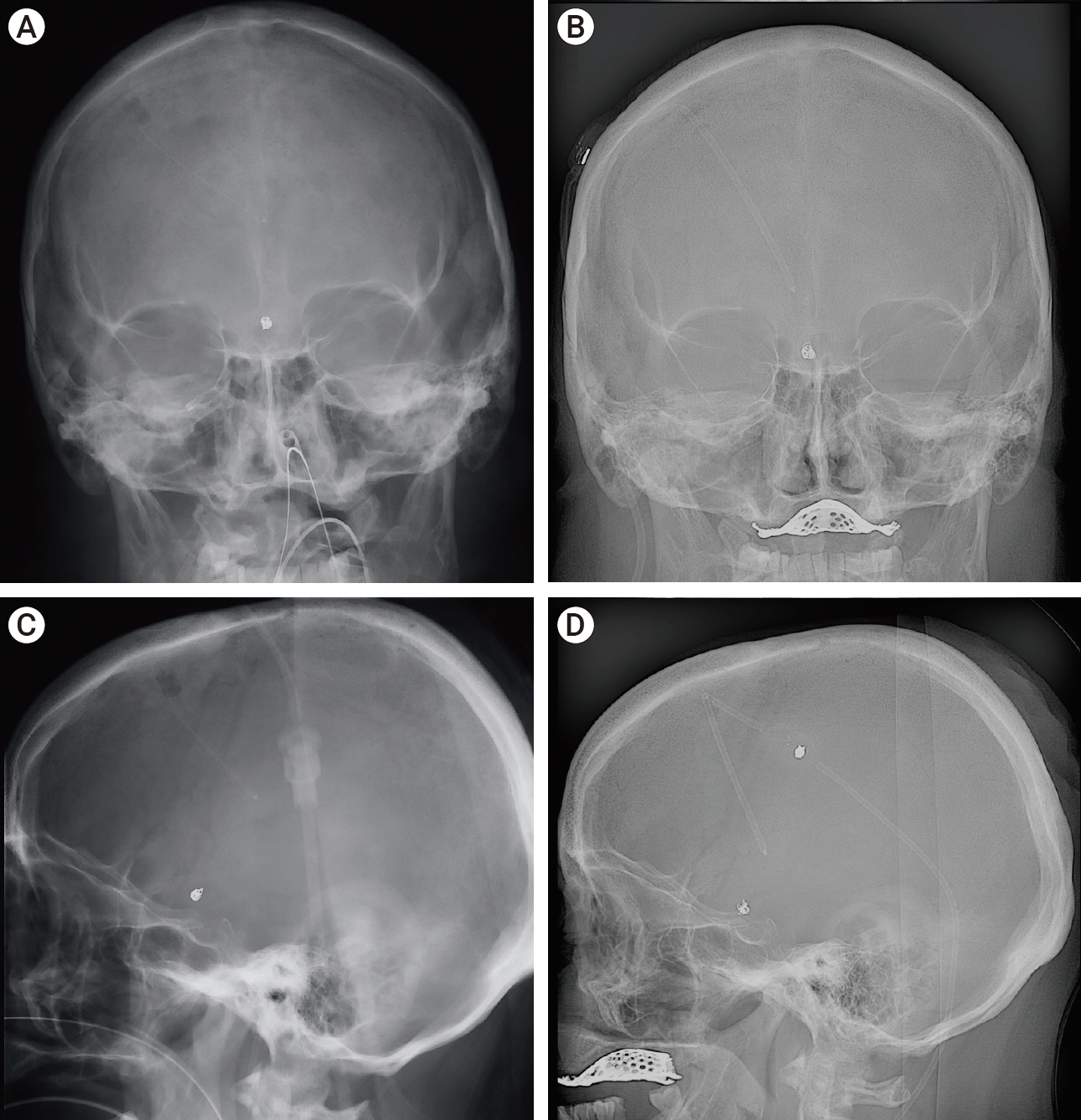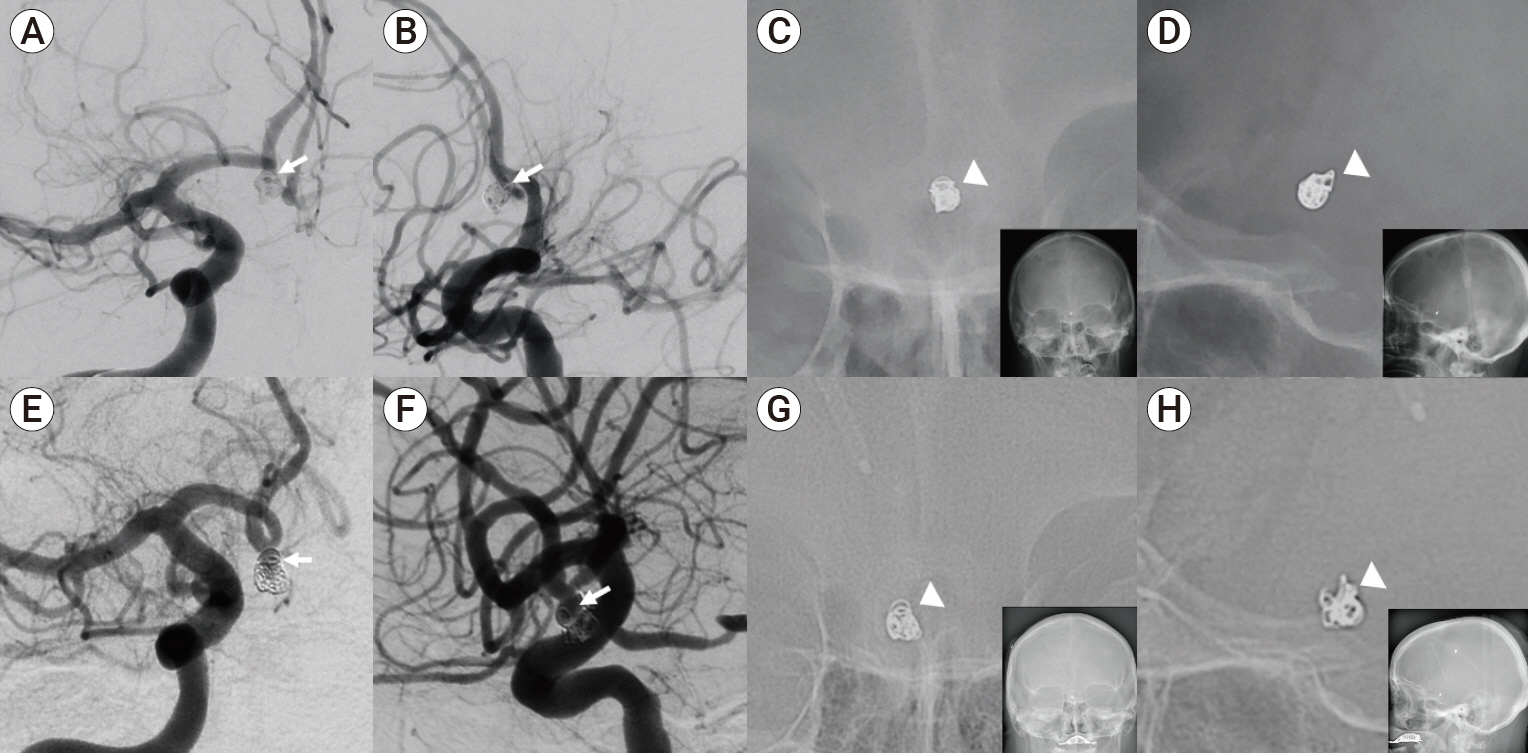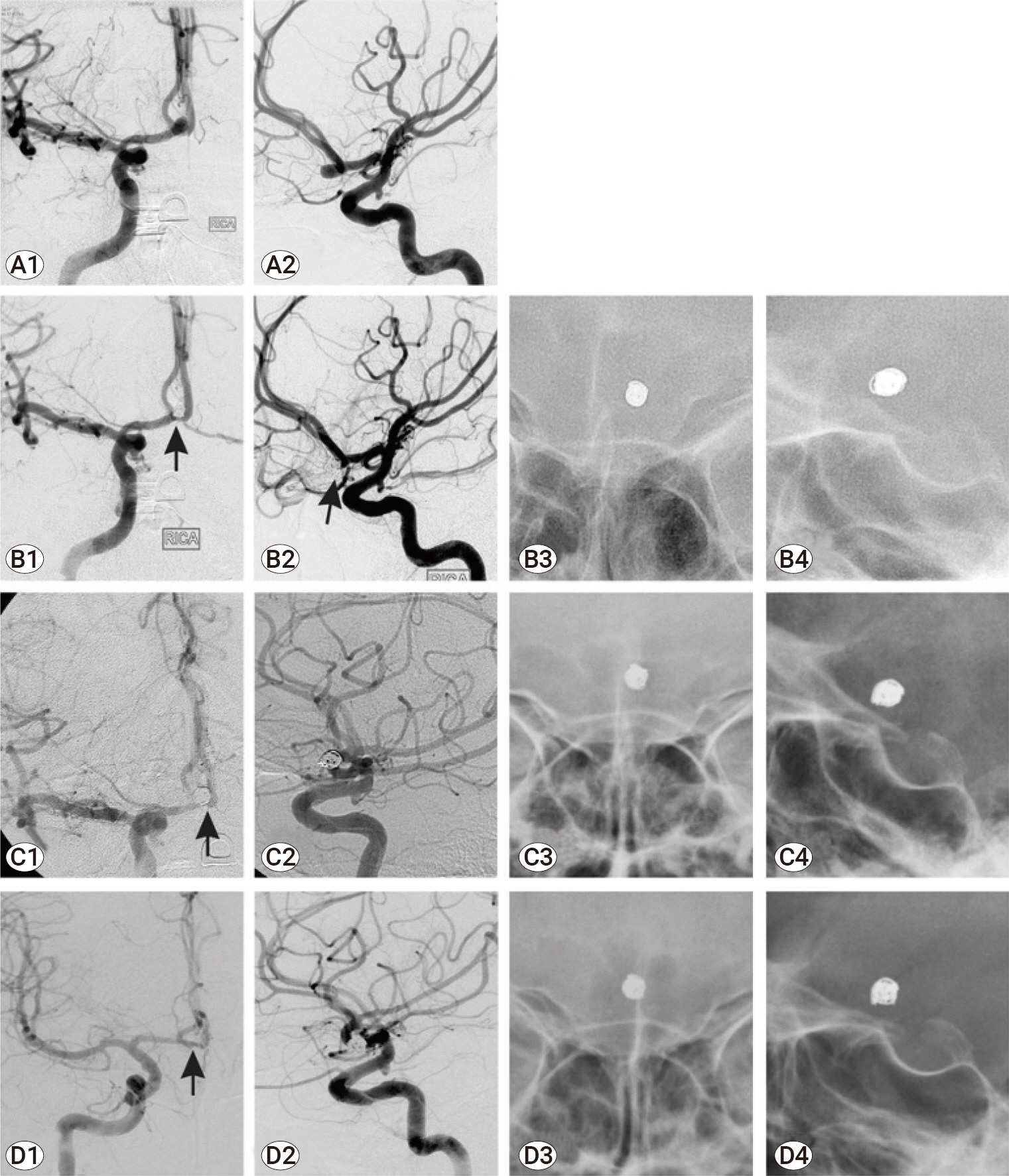J Cerebrovasc Endovasc Neurosurg.
2021 Jun;23(2):108-116. 10.7461/jcen.2021.E2020.10.002.
Utility of skull X-rays in identifying recurrence of coiled cerebral aneurysms
- Affiliations
-
- 1Department of Neurosurgery, University of Texas McGovern Medical School, Houston, TX, USA
- 2Department of Neurology, University of Texas McGovern Medical School, Houston, TX, USA
- 3Department of Neurosurgery, Temple University, Philadelphia, PA, USA
- KMID: 2517023
- DOI: http://doi.org/10.7461/jcen.2021.E2020.10.002
Abstract
Objective
A high rate of cerebral aneurysm recurrence following endovascular coiling has prompted the use of digital subtraction angiography (DSA) for interval follow-up. However, the utility of skull x-rays as an alternative screening method for aneurysm recurrence is unproperly characterized.
Methods
Retrospective review of a prospective registry of ruptured and unruptured cerebral aneurysms. Anteroposterior and lateral skull x-rays were obtained immediately at the end of the procedure and at 6-month follow-up. Aneurysm recurrence was defined by comparing post-procedure and 6-month DSA imaging. A true positive was defined as a change in coil mass morphology on at least one projection with aneurysm recurrence on DSA, and a true negative defined as a stable coil mass on both projections and no recurrence on DSA. Receiver operating characteristic area under the curve (AUC) statistics was used to assess the performance of skull x-rays in identifying aneurysm recurrence.
Results
A total of 118 cerebral aneurysms were evaluated with DSA imaging and skull x-rays. A change in coil mass morphology on one projection of skull x-rays correctly detected all true recurrences with a sensitivity of 100% (95% confidence interval [CI], 91-100%). Skull x-rays failed to identify a stable aneurysm coil mass in 15 cases, with a specificity of 79% (68-88%). Skull x-rays performed with AUC 0.8958 (95% CI, 0.8490-0.9431) in identifying aneurysm recurrence.
Conclusions
The findings of our study suggest that skull x-rays may represent a lowcost, non-invasive screening tool to rule out aneurysm recurrence, which can potentially aid in decreasing the utilization of DSA in the follow-up of patients with coiled cerebral aneurysms.
Figure
Reference
-
1. Campi A, Ramzi N, Molyneux AJ, Summers PE, Kerr RS, Sneade M, et al. Retreatment of ruptured cerebral aneurysms in patients randomized by coiling or clipping in the International Subarachnoid Aneurysm Trial (ISAT). Stroke. 2007; May. 38(5):1538–44.
Article2. Cloft HJ, Joseph GJ, Dion JE. Risk of cerebral angiography in patients with subarachnoid hemorrhage, cerebral aneurysm, and arteriovenous malformation: a meta-analysis. Stroke. 1999; Feb. 30(2):317–20.3. Connor SE, West RJ, Yates DA. The ability of plain radiography to predict intracranial aneurysm occlusion instability during follow-up of endosaccular treatment with Gugliemi detachable coils. Neuroradiology. 2001; Aug. 43(8):680–6.
Article4. Cottier JP, Bleuzen-Couthon A, Gallas S, Vinikoff-Sonier CB, Bertrand P, Domengie F, et al. Follow-up of intracranial aneurysms treated with detachable coils: comparison of plain radiographs, 3D time-of-flight MRA and digital subtraction angiography. Neuroradiology. 2003; Nov. 45(11):818–24.
Article5. Darsaut TE, Raymond J. Barrow ruptured aneurysm trial: 3-year results. J Neurosurg. 2013; Dec. 119(6):1642–4.6. D'Urso PI, Karadeli HH, Kallmes DF, Cloft HJ, Lanzino G. Coiling for paraclinoid aneurysms: time to make way for flow diverters? AJNR Am J Neuroradiol. 2012; Sep. 33(8):1470–4.7. Fargen KM, Blackburn S, Deshaies EM, Carpenter JS, Jabbour P, Mack WJ, et al. Final results of the multicenter, prospective Axium MicroFX for Endovascular Repair of IntraCranial Aneurysm Study (AMERICA). J Neurointerv Surg. 2015; Jan. 7(1):40–3.
Article8. Heiserman JE, Dean BL, Hodak JA, Flom RA, Bird CR, Drayer BP, et al. Neurologic complications of cerebral angiography. AJNR Am J Neuroradiol. 1994; Sep. 15(8):1401–7. discussion 1408-11.9. Henkes H, Fischer S, Liebig T, Weber W, Reinartz J, Miloslavski E, et al. Repeated endovascular coil occlusion in 350 of 2759 intracranial aneurysms: safety and effectiveness aspects. Neurosurgery. 2008; Jun. 62(6 Suppl 3):1532–7.
Article10. Henkes H, Fischer S, Mariushi W, Weber W, Liebig T, Miloslavski E, et al. Angiographic and clinical results in 316 coil-treated basilar artery bifurcation aneurysms. J Neurosurg. 2005; Dec. 103(6):990–9.
Article11. Hwang GJ, Berenstein A, Niimi Y, Setton A, Pryor J, Baltsavias G, et al. The accuracy of plain skull x-ray examination as a predictor of recanalization following Guglielmi detachable coil embolisation in the treatment of cerebral aneurysms. Interv Neuroradiol. 2000; Sep. 6(3):195–202.
Article12. Kaufmann TJ, Huston J 3rd, Cloft HJ, Mandrekar J, Gray L, Bernstein MA, et al. A prospective trial of 3T and 1.5T time-of-flight and contrast-enhanced MR angiography in the follow-up of coiled intracranial aneurysms. AJNR Am J Neuroradiol. 2010; May. 31(5):912–8.
Article13. Koltz MT, Chalouhi N, Tjoumakaris S, Fernando Gonzalez L, Dumont A, Hasan D, et al. Short-term outcome for saccular cerebral aneurysms treated with the Orbit Galaxy Detachable Coil System. J Clin Neurosci. 2014; Jan. 21(1):148–52.
Article14. Lavoie P, Gariépy JL, Milot G, Jodoin S, Bédard F, Trottier F, et al. Residual flow after cerebral aneurysm coil occlusion: diagnostic accuracy of MR angiography. Stroke. 2012; Mar. 43(3):740–6.15. Lecler A, Raymond J, Rodriguez-Régent C, Al Shareef F, Trystram D, Godon-Hardy S, et al. Intracranial aneurysms: recurrences more than 10 years after endovascular treatment-a prospective cohort study, systematic review, and meta-analysis. Radiology. 2015; Oct. 277(1):173–80.
Article16. Mascitelli JR, Moyle H, Oermann EK, Polykarpou MF, Patel AA, Doshi AH, et al. An update to the Raymond-Roy Occlusion Classification of intracranial aneurysms treated with coil embolization. J Neurointerv Surg. 2015; Jul. 7(7):496–502.
Article17. McDougall CG, Spetzler RF, Zabramski JM, Partovi S, Hills NK, Nakaji P, et al. The barrow ruptured aneurysm trial. J Neurosurg. 2012; Jan. 116(1):135–44.
Article18. Molyneux A, Kerr R, Stratton I, Sandercock P, Clarke M, Shrimpton J, et al. International Subarachnoid Aneurysm Trial (ISAT) of neurosurgical clipping versus endovascular coiling in 2143 patients with ruptured intracranial aneurysms: a randomised trial. Lancet. 2002; Oct. 360(9342):1267–74.
Article19. Molyneux AJ, Kerr RS, Yu LM, Clarke M, Sneade M, Yarnold JA, et al. International subarachnoid aneurysm trial (ISAT) of neurosurgical clipping versus endovascular coiling in 2143 patients with ruptured intracranial aneurysms: a randomised comparison of effects on survival, dependency, seizures, rebleeding, subgroups, and aneurysm occlusion. Lancet. 2005; Sep. 366(9488):809–17.
Article20. Murayama Y, Viñuela F, Ishii A, Nien YL, Yuki I, Duckwiler G, et al. Initial clinical experience with matrix detachable coils for the treatment of intracranial aneurysms. J Neurosurg. 2006; Aug. 105(2):192–9.
Article21. Pierot L, Portefaix C, Boulin A, Gauvrit JY. Follow-up of coiled intracranial aneurysms: comparison of 3D time-of-flight and contrast-enhanced magnetic resonance angiography at 3T in a large, prospective series. Eur Radiol. 2012; Oct. 22(10):2255–63.
Article22. Raymond J, Guilbert F, Weill A, Georganos SA, Juravsky L, Lambert A, et al. Long-term angiographic recurrences after selective endovascular treatment of aneurysms with detachable coils. Stroke. 2003; Jun. 34(6):1398–403.
Article23. Ringer AJ, Lanzino G, Veznedaroglu E, Rodriguez R, Mericle RA, Levy EI, et al. Does angiographic surveillance pose a risk in the management of coiled intracranial aneurysms? A multicenter study of 2243 patients. Neurosurgery. 2008; Nov. 63(5):845–9. discussion 849.
Article24. Satoh T, Hishikawa T, Hiramatsu M, Sugiu K, Date I. Visualization of aneurysmal neck and dome after coiling with 3D multifusion imaging of silent MRA and FSE-MR cisternography. AJNR Am J Neuroradiol. 2019; May. 40(5):802–7.
Article25. van Amerongen MJ, Boogaarts HD, de Vries J, Verbeek AL, Meijer FJ, Prokop M, et al. MRA versus DSA for follow-up of coiled intracranial aneurysms: a meta-analysis. AJNR Am J Neuroradiol. 2014; Sep. 35(9):1655–61.
Article26. Wang Y, Li Y, Jiang C, Jiang F, Meng H, Siddiqui AH, et al. Endovascular treatment of paraclinoid aneurysms: 142 aneurysms in one centre. J Neurointerv Surg. 2013; Nov. 5(6):552–6.
Article
- Full Text Links
- Actions
-
Cited
- CITED
-
- Close
- Share
- Similar articles
-
- Microsurgical management of previously embolized intracranial aneurysms: A single center experience and literature review
- Recurrent Giant Cell Tumor of Skull Combined with Multiple Aneurysms
- Microsurgical Clipping and Coil Removal of Previously Coiled Regrowing Cerebral Aneurysms
- Traumatic Intracranial Aneurysms: Report of Six Cases
- De Novo Intracranial Aneurysms Detected on Imaging Follow-Up of Coiled Aneurysms in a Korean Population




